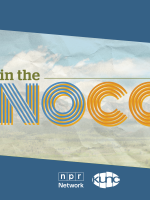When we see weeds start to pop up in the yard or the garden, the first instinct for many of us is to figure out how to get rid of them.
But here's the thing: Many plants we might regard as ugly or invasive are, in fact, edible.
Orion Aon learned this in his early years growing up in Santa Fe, New Mexico. He would go on camping trips with family and friends – who gave him some of his first lessons in finding food in the wild.

Today, he is the owner of Forage Colorado. He began the business in 2015, initially as a way to create a community with fellow foragers to share stories and knowledge.
"It turns out that there weren't that many people doing that, at least online, and sharing about it at the time," Aon says. "So it quickly turned into me teaching other people what I knew."
Now, he shows clients how to connect with nature by finding and and preparing wild foods like dandelions, tumble mustard, and curly dock.
Here at In The NoCo, we like to talk to folks with unique businesses. Orion was kind enough to take host Erin O'Toole out on a foraging lesson along a trail in her neighborhood.
You can read Orion's tips on ; aka wild spinach.
In 2023, he spoke with KUNC about the potential harm from AI-written foraging guide books, which you can read here.
UPDATE: After we released this episode, we got a helpful note from a friend with the Fort Collins Natural Areas department: Many natural areas in Northern Colorado (and elsewhere) do not allow people to gather or remove plants, seeds or other materials from the site. This is to protect natural areas from being over-harvested, and also helps protect food for wildlife. In addition, plants in natural areas may be sprayed with toxic pesticides or herbicides. Be sure to check the regulations for any places you visit. And don't go foraging in areas that may have been sprayed with toxic substances!






